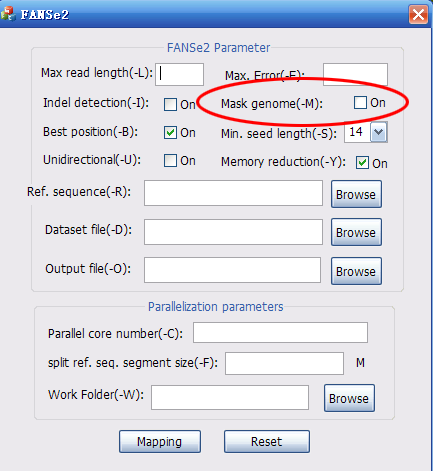Troubleshooting and
Frequently Asked Questions (FAQ)
FANSe2 is a newly developed program and we are improving it constantly. We tested it already with many datasets acquired with different sequencing platforms to various reference genomes like E.coli, mouse, human, some plant species, etc. FANSe works quite stably. We will continue testing it and improving it when some problems appear. Note that the steps listed here in the instructions should be followed thoroughly. Wrong parameter in the settings may result in an unpredictable error message in the end; the program does not point out all mistakes immediately. Please contact us immediately if you experience any problems. Here we list some of the frequently asked questions and the solution.
Frequently Asked Questions (FAQ)
(1) The precompiled FANSe2 program downloaded from the website doesn’t run on our old computer with AMD CPU, but runs on our newest computer with Intel i5 CPU.
Answer: The problem is due to the instruction sets. Although our codes are hardware-independent, SIMD instruction set optimization can yield additional 2x speedup. Therefore, our pre-compiled versions are optimized for the CPUs with SSE4 and higher instruction sets (Intel i3/i5/i7 from the first generation, AMD Phenom II or higher).
Solution: Please be sure that your CPU supports the SSE4 instruction set. If you need to run FANSe2 in old CPU or non-X86/X64 CPUs, please contact us and we may compile it accordingly for your CPU.
(2) I use the original FASTQ sequencing dataset from Illumina HiSeq-2000 to perform the mapping. However, FANSe2 gives chaotic result.
Answer: Be sure that the name of each read in the FASTQ file cannot contain space or tab. The original FASTQ data from Illumina sequencers usually contains space as below:
@HWI-ST1106:529:H0E5GADXX:1:1101:1470:2113 1:N:0:ATCACG
Note that there is a space between “2113” and “1:N:0”. This will confuse FANSe2.
Solution: Rename the read names to eliminate space and tab. You can use our “Prefiltering” tool (downloadable in “Utilities” section) to rename the read names
(3) I downloaded the complete genome of a bacteria from NCBI database and use it as the reference genome sequence. However the result is weird. The locations and the name of reference sequence are totally messed up.
Answer: Be sure that the name of each reference sequence cannot contain space or tab. The downloaded FASTA sequence, especially the genome sequences, often contain lots of spaces, like following:
>gi|126640115|ref|NC_009085.1| Acinetobacter baumannii ATCC 17978 chromosome, complete genome
This is a typical FASTA sequence name from NCBI database. Note that there are multiple spaces. In addition, too long name may reduce the output speed and may cause unpredicable results.
Similar problem may occur if you use RefSeq-RNA reference sequence downloaded from UCSC, since the sequence names contain space like this:
>NM_004676 1
Solution: Rename the reference sequence names to eliminate space and tab. Although the program theoretically supports names up to 100 characters, we strongly recommend you to restrict the length of the name shorter than 50 characters.
If you use RefSeq-RNA reference sequence downloaded from UCSC, you may use our
"RenameRefSeq" tool to remove the spaces and the version suffix.
(4) I used RefSeq-RNA reference sequence (spaces removed) as reference transcriptome sequence. However, the mapping finished in one minute and resulted in nothing - no reads were mapped.
Answer: RefSeq-RNA reference sequence is usually given in lower case letters, like this:
>NM_004676
aagaagaggagcacaccacaccagaaacagacatcttgcagtgtttcact
gtctcaaccttatctgcacagtccgaggtcagtctgagagagcttctgag
agacccaggatgaagggatgcagtgaggtcaagagcccaaccttctttca
...
Lower case letters are considered as "masked genome" and will be discarded if the "Mask genome" option is on.
Solution: Switch off the "Mask genome" option, or use "-M0" in the command-line version. By default, "Mask genome" option is on. So please uncheck the box.

(5) When mapping Ion Torrent data, FANSe2 was terminated unexpectedly with fatal error.
Answer: FANSe2 requires a minimum read length of 14. Any read less than 14 nt long will trigger a fatal error. Ion Torrent sequencers (and also some other sequencers) give occasionally very short reads.
Solution: Filter the raw reads and discard those very short reads <14-nt. They cannot be reliably mapped anyhow. Nevertheless, to ensure an accurate mapping, we recommend that you map >=18-nt reads.
(6) FANSe2 with indel detection was terminated unexpectedly with fatal error. I'm sure that all the reads are long enough. However, when indel detection was turned off, the mapping completed smoothly.
Answer: The maximum read length (-L) parameter is too low. When indel detection is on, you should set this parameter larger.
Solution: Assume your maximum read length in the FASTQ dataset is X, and the error allowance (-E) is Y, the maximum read length (-L) parameter should be at least X+2Y.
